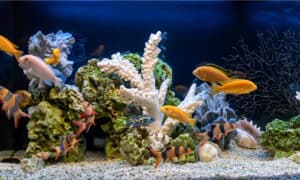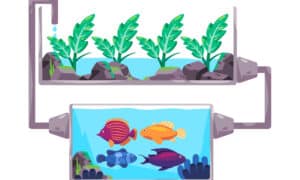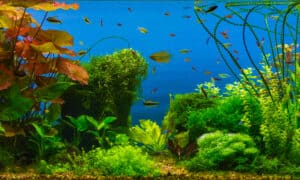| Best for | Product |
|---|---|
| Best Overall | Aqueon Goldfish Flaked Fish Food |
| Best Budget | TetraFin Goldfish Variety Pellet Food |
| Best for Sensitive Digestive Systems | Omega One Goldfish Pellets, Sinking |
| Best Professional Grade | Hikari Saki Fancy Goldfish |
While some may see a goldfish as a great first pet for their child, others are goldfish enthusiasts. No matter where you fall within the spectrum of goldfish owners, it can take a lot of work to find the proper food for your pet’s diet.
Goldfish require a wide variety of nutrients in order to thrive. But it’s not always easy to know what they need. For example, there’s a oft-repeated myth that you shouldn’t give goldfish floating food. Our expert researchers discovered that floating food is perfectly healthy and that many fish prefer it.
Our handy guide will teach you about how you should feed your goldfish, what to avoid, and the best goldfish foods on the market today!
 Check Chewy Check Amazon
Check Chewy Check Amazon- Flakes feature all-natural ingredients
- Includes vitamins and minerals
- Won't cloud water
- Float on the surface
- Formulated for specific species, including goldfish
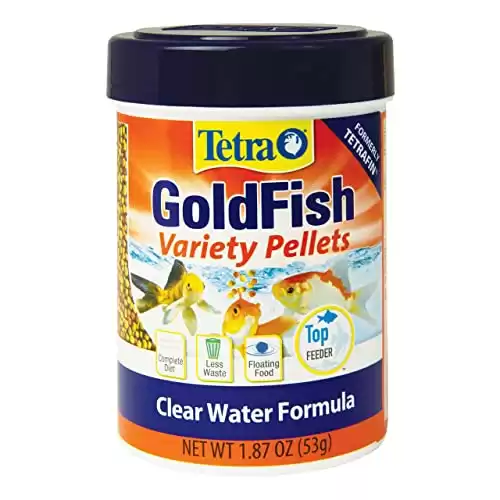 Check Amazon
Check Amazon- Budget-friendly
- Contains Tetra's proprietary ProCare ingredient for immune health and longevity
- The recipe includes extremely nutritious foods, vitamins, minerals, and trace elements
- Works to bring out your goldfishes' best colors
- A vibrant blend of floating pellets for nutritional diversity
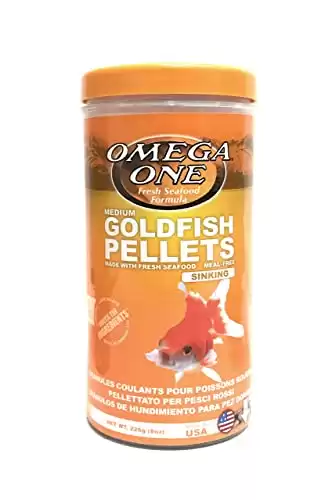 Check Amazon
Check Amazon- Perfect for goldfish with sensitive digestive systems
- Contains omega-3 and omega-6 fatty acids for a healthy immune system
- Bring out the color of your fish
- Lower starch than many fish foods
- These pellets sink to the bottom of the tank for easy consumption
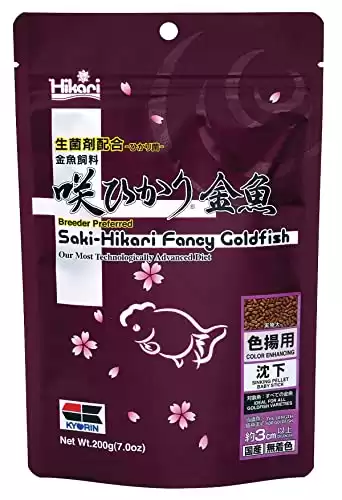 Check Amazon
Check Amazon- Professional-grade, goldfish-specific daily food
- Sinking pellets are easy for your goldfish to find and eat
- Contain probiotics, wheat germ, and seaweed for digestive health
- Also contains color-enhancing additives to enhance your goldfishes' red hues without distorting white areas
- Vitamins E and C support immune health
A-Z-Animals’ Top Picks for the Healthiest and Best Goldfish Food for Your Pet
#1 Best Overall: Aqueon Goldfish Flaked Fish Food
After scrutinizing the wide variety of fish food available today, the Aqueon Goldfish Flaked Fish Food is our top choice. One of our favorite things about this option is that it has all-natural ingredients. These ingredients give the flakes a beautiful color. Aqueon Goldfish Flaked Fish Food does add minerals and vitamins to provide a well-balanced diet for your fish.
Experienced goldfish owners love that these flakes won’t cloud the water of the tank or pond when fed as directed. They float on the surface and are formulated for specific types of pond fish, including goldfish. Overall, this is a great choice for any fish owner to add to their swimming pal’s diet.
Several reviewers said that the food was too powdery.
Pros and Cons of Aqueon Goldfish Flaked Fish Food
| Pros | Cons |
|---|---|
| This goldfish food has natural ingredients and colors. | Several reviewers said that the food was too powdery. |
| The formula is enhanced with vitamins and minerals to ensure that your goldfish get balanced diet. | |
| When fed as directed, these flakes won’t cloud the water of your tank or pond. | |
| They float on the surface and are formulated for goldfish and some other pond fish. |
- Flakes feature all-natural ingredients
- Includes vitamins and minerals
- Won't cloud water
- Float on the surface
- Formulated for specific species, including goldfish
2. Best Budget: Tetra TetraFin Bite-Sized Floating Variety Pellets
As a fish owner, you don’t have to spend more than a few bucks to get high-quality food like Tetra TetraFin Bite-Sized Floating Variety Pellets for your fish. This budget-friendly option contains Tetra’s proprietary ProCare ingredient, which promotes immune system health and longevity. Optimal nutrition is provided by a carefully created blend of extremely nutritious foods, as well as vitamins, minerals, and trace elements. Plus, Tetra TetraFin Bite-Sized Floating Variety Pellets work to bring out your fish’s natural bright colors.
These bite-sized floating pellets float at the surface of the water and are easy to feed. Smaller ponds might also benefit from these floating variety pellets. This vibrant blend of little fish food offers nutritional diversity for your goldfish.
A few pet parents said that their goldfish didn’t like this food.
Pros and Cons of Tetra TetraFin Bite-Sized Floating Variety Pellets
| Pros | Cons |
|---|---|
| This budget-friendly floating pellet food contains Tetra’s ProCare ingredient, which promotes immune system health and longevity. | A few pet parents said that their goldfish didn’t like this food. |
| These pellets feature a carefully crafted blend of nutritious foods as well as vitamins, minerals, and trace elements. | |
| These pellets work to bring out your fish’s natural bright colors. | |
| They float at the surface of the water. | |
- Budget-friendly
- Contains Tetra's proprietary ProCare ingredient for immune health and longevity
- The recipe includes extremely nutritious foods, vitamins, minerals, and trace elements
- Works to bring out your goldfishes' best colors
- A vibrant blend of floating pellets for nutritional diversity
3. Best for Sensitive Digestive Systems: Omega One Medium Sinking Goldfish Pellets Fish Food
If your goldfish has a sensitive digestive system (yes, it’s possible!) you need Omega One Medium Sinking Goldfish Pellets Fish Food. Omega One developed these sinking pellets with a high quantity of omega-3 and omega-6 fatty acids, which aid in the development of your fish’s immune system in much the same way that these fatty acids aid in the development of human immune systems. They also have less starch compared to many other products. And natural beta-carotene from salmon provides extreme color enhancement.
These pellets sink to the bottom of the tank, making them easier to consume. We do want to add that you should be mindful when choosing an amount to give your fish. These pellets have a tendency to cloud the tank when left uneaten.
A handful of reviewers said that these pellets don’t sink.
Pros and Cons of Omega One Medium Sinking Goldfish Pellets Fish Food
| Pros | Cons |
|---|---|
| These sinking pellets were developed specifically for goldfish with sensitive digestive systems. | These pellets have a tendency to cloud the tank when left uneaten. |
| They include a high quantity of omega-3 and omega-6 fatty acids to aid your goldfish’s immune system development. | A handful of reviewers said that these pellets don’t sink. |
| They contain significantly less starch than many other fish foods. | |
| Natural beta-carotene from salmon provides extreme color enhancement. | |
| They sink to the bottom of the tank so they’re easier for fish to find and consume. |
- Perfect for goldfish with sensitive digestive systems
- Contains omega-3 and omega-6 fatty acids for a healthy immune system
- Bring out the color of your fish
- Lower starch than many fish foods
- These pellets sink to the bottom of the tank for easy consumption
4. Best Professional Grade: Saki-Hikari Fancy Goldfish
If you’re searching for a professional-grade, goldfish-specific prepared meal to feed on a daily basis, we recommend Saki-Hikari Fancy Goldfish. These small sinking pellets are packed with probiotics, wheat germ, and seaweed to help with digestion and gut flora health.
Color-enhancing additives like astaxanthin and spirulina assist to improve the red hue of your goldfish without distorting the white parts. Finally, vitamins E and C are included in these pellets to support your fish’s immune system health. It’s no surprise that the Saki-Hikari line of specialist goldfish feeds has become so popular.
Some fish keepers said this food was appropriate only for fry and small goldfish, not large ones. Some others said that this food left their water cloudy.
Pros and Cons of Saki-Hikari Fancy Goldfish
| Pros | Cons |
|---|---|
| These small sinking pellets include probiotics, wheat germ, and seaweed to support digestion and gut flora health. | Some reviewers said this food was appropriate only for fry and small goldfish, not large ones. |
| Astaxanthin and spirulina improve your goldfish’s red hues without distorting the white areas. | Others said that this food left their water cloudy. |
| Vitamins E and C support your goldfish’s immune health. |
- Professional-grade, goldfish-specific daily food
- Sinking pellets are easy for your goldfish to find and eat
- Contain probiotics, wheat germ, and seaweed for digestive health
- Also contains color-enhancing additives to enhance your goldfishes' red hues without distorting white areas
- Vitamins E and C support immune health
Choosing the Best: What to Look For
Just like anything else you buy for your fish, like a tank, plants, or filters, there are certain things you’ll want to be aware of when shopping for food. We’ve created a convenient buyer’s guide that has everything you need to know about choosing the next goldfish food for your finned friend.
Ingredients
You want high-quality ingredients in your fish food, just like you would for any of your other pets. Initially, you’ll need a solid amount of protein, which normally comes from peas or other forms of fish, but it may come from a variety of sources, including fly larvae.
Goldfish can benefit from probiotics and omega fatty acids, so look for foods that contain these elements. Goldfish don’t manufacturer vitamin C in their bodies, so they must receive it in their food in order to grow healthy and strong. So you will want to look for fish food that contains it.
Color Enhancement
Most people want to improve their goldfish’s color, and you can usually do so by changing the ingredients in their food. Carotenoids, which are found in carrots, peas, and a variety of other vegetables, are included in most color-enhancing meals to improve the orange color of goldfish.
Nutrition Density
Pellet food is five to 10 times denser in weight than flake food. This means you can provide more nourishment per mouthful, but it also means you may easily overfeed the goldfish in your aquarium or pond.
Frozen food includes a lot of water (up to 75 percent), so you’re effectively injecting nutrient-rich water into the tank. Washing and target feeding frozen food is the most effective way to avoid large amounts of waste, whereas pellets and flakes are best for broadcast feeding into the fish tank.
The Different Types of Goldfish Food: Pros and Cons Compared
There are several types of goldfish food on the market. Let’s take a look at a short description of each, along with their pros and cons.
Flakes
The ingredients are combined, dried, and then spread paper-thin before being baked. Flake food is ideal for fish that eat on the surface or in the middle of the water column. Flakes that settle to the bottom of the substrate will be eaten by bottom feeders.
Pellets
Pellets are similar to flakes, except instead of paper-thin flakes, they’re fashioned into small, thick balls or sticks, akin to dog kibble. They can be either floating or sinking, which is preferable for top-feeding fish or mid-water and bottom-feeding fish. Pellets are a good alternative for bigger fish, such as cichlids from South America.
Sinking Wafers
These consist of hard discs of dry food that settle instantly, comparable to pellets. Catfish and plecos, for example, are bottom-dwelling creatures. These are frequently marketed as “algae wafers,” but beware: many of them contain little to no algae and are comprised of inferior components.
Gel Fish Food
Gel food is a powder that has to be mixed with hot water. It thickens into firm gelatine, similar to Jello. Fish and invertebrates, believe it or not, go bananas about it. It’s particularly useful if you have sick fish because drugs may be mixed straight into the diet for quick delivery.
Freeze Dried
Freeze-dried foods are generally whole foods that have been freeze-dried, such as whole bloodworms or brine shrimp. These have a long shelf life and are a terrific way to add variety to your fish’s diet.
Freeze-dried food, on the other hand, should be reserved for special occasions. Making them the mainstay of your fish’s diet isn’t feasible since the amount of food you’d have to feed your fish would be tremendous.
Live Shrimp
Live snacks are little critters that you give to your fish to eat. Small invertebrates such as daphnia, brine shrimp, or ghost shrimp might be the best option if your goldfish prefers live food.
To be honest, we don’t believe this is a fantastic idea, because “feeder” species are generally maintained in deplorable conditions. A feeder fish is only as healthy as the food it consumes. As a result, a skinny, half-starved feeder fish doesn’t offer many nutrients.
Frozen Fish Food
Frozen foods are entire food products that have been gathered and frozen into cubes, which you can then thaw and give to your fish. Bloodworms, brine shrimp, algae mixtures, and beef heart are also common meals.
Because these feeds contain roughly 70% water, you’ll need to give your fish a larger amount than if you were using dry food. We also advise you to avoid using beef heart. Many fish breeders love it, however, this type of protein can strain a fish’s kidneys and limit its lifetime.
How to Feed Your Goldfish
Goldfish are grazers by nature. Goldfish are constantly searching for food in their pond or aquarium. Because they don’t have a stomach, many tiny feedings each day are recommended for optimum development. Multiple feedings are necessary if you really want your fish to develop as quickly as possible.
Feeding twice a day, once in the morning and once in the evening, would be a more realistic method. Flakes and floating granules will attract fish to the tank or pond’s surface. A feeding clip can be used to suspend leafy greens in aquariums. This provides a feeding place for the goldfish, where they can tear a piece of foliage off whenever they please.
Citrus slices may be tossed into ponds or left to float in aquariums. Food that has not been consumed will ultimately degrade and pollute the water. After 10 minutes, remove any uneaten pellets or flakes. The fish will not consume the leftover food once they are satisfied.
You may be adding too much food at once if you continue to find uneaten food in their tank. Be sure to remove uneaten food at least once per day.
Avoid Overfeeding
When goldfish notice you, they will rush to the front of the aquarium. They’re quite intelligent and will identify you. Admittedly, you’re the one who feeds them on a daily basis. The fish’s learned behavior does not indicate that they are hungry, it simply means that they expect to be fed.
A goldfish pond would be the same way. While pond fish are wary of intruders, they will become accustomed to seeing you at the water’s edge. If you establish a feeding schedule, they may even know when to anticipate you.
But don’t be tricked into believing the fish require constant feeding. In the same way that dogs can beg for food off of your dinner plate, goldish will try to sneak some extra food as well!
Unused food creates hazardous ammonia and nitrite build-up in the water, resulting in poor water quality. It can create problems with algae as well. As food decomposes, nutrients that promote algae growth are released into the water.
Uneaten goods fall into the gravel, resulting in a sludge layer that is unsightly and can make cleaning the tank more work. In addition, having a dirty pond or aquarium can lead to health issues for your finned friend.
| Best for | Product |
|---|---|
| Best Overall | Aqueon Goldfish Flaked Fish Food |
| Best Budget | TetraFin Goldfish Variety Pellet Food |
| Best for Sensitive Digestive Systems | Omega One Goldfish Pellets, Sinking |
| Best Professional Grade | Hikari Saki Fancy Goldfish |
The Healthiest and Best Goldfish Food for Your Pet FAQs (Frequently Asked Questions)
How frequently do you feed your goldfish?
Adult goldfish should only be fed a high-protein diet once a day. To grow big and robust, smaller fish require more frequent feedings of little quantities. They can still eat as much vegetables as they want at any time, so you aren’t starving them.
What brings joy to a goldfish?
Goldfish spend a lot of time wandering their tanks to keep themselves entertained, so make your tank as stimulating as possible for them. Gravel, plants, decorations, and airflows may all provide variety to your fish’s existence.
What is the maximum amount of time a goldfish can spend without eating?
Goldfish can endure up to two weeks without food, but it’s not a good idea to keep your fish hungry for that long because confined goldfish have a regular feeding schedule. If you’ll be gone for more than three or four days, ensure sure your goldfish are fed on a regular basis.
Thank you for reading! Have some feedback for us? Contact the AZ Animals editorial team.

